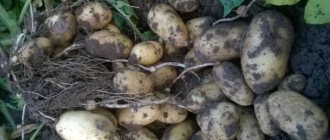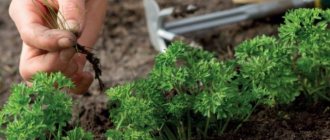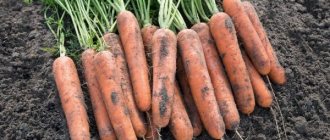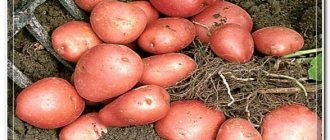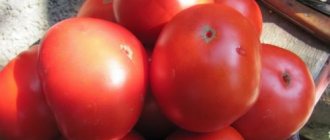Queen of Autumn is a late-ripening carrot variety. Unpretentiousness in care and resistance to various diseases have made this type of culture one of the most popular. The variety has certain characteristics that relate to external and taste characteristics, cultivation and harvesting.
Carrot seeds Queen of Autumn
Carrot Queen of Autumn is low maintenance
Carrot Queen of Autumn
Description of the variety
One of the features of the Queen of Autumn is its high carotene content (12-15%). This causes the characteristic orange color of the root vegetables, although it is not overly saturated. The variety is late-ripening, the growing season is 120-130 days.
The Queen of Autumn is characterized by a spreading rosette of leaves. The leaves are medium in size and light green in color.
Root vegetables have a regular elongated shape, the length can reach 30 cm. The weight averages 0.16-0.2 kg. Sugar content – 6-11%. Productivity – up to 9 kg per 1 sq. m.
Queen of Autumn is a cold-resistant variety - it is not afraid of temperatures down to -4 degrees. This provides the possibility of early sowing, as well as harvesting already during frosts. This property allows you to successfully grow carrots even in northern latitudes.
Advantages and disadvantages
The popularity of the Queen of Autumn among gardeners is due to its many advantages:
- excellent taste characteristics;
- fairly large root vegetables;
- high germination of seeds, fruits ripen together;
- disease resistance;
- high productivity;
- possibility of long-term storage while maintaining taste;
- versatility - carrots can be eaten fresh, used for cold and hot dishes, and canned in various ways.
These advantages are countered by several disadvantages of the variety:
- different sizes of root vegetables;
- when planting in dense soil, difficulties arise in extracting root crops due to their large length;
- The orange color is not too saturated.
Soil requirements
The soil for planting the Queen of Autumn must be prepared in advance. Preferably light fertile soil with good water permeability. If the soil is too heavy, there is a high risk of crust formation, which makes it difficult for the crop to germinate and can lead to deformation of the root crops.
The selected area for planting should be dug up at the end of autumn. Be sure to fertilize the soil. Repeat the entire algorithm in the spring. It is good to use ash and humus as fertilizer - you need to add them several weeks before planting.
Fresh manure and nitrogen fertilizers should be discarded. The Queen of Autumn does not like high acidity, and when nitrogen is used in root crops, nitrates will accumulate in large quantities.
The area for planting the Queen of Autumn should be level and well lit. The garden bed should not be located near trees or in a low area.
Landing rules
It is important to properly prepare the seeds for planting. They should be placed in warm water for a day, which must be replaced every 3 hours. After soaking, the seeds should be washed and stored in the refrigerator. This preparation allows you to speed up seed germination.
You can soak the seeds for several hours, and then leave them for another 20 hours in a damp cloth. This also ensures their swelling, which is necessary to speed up germination.
The Queen of Autumn is planted in late April or early May. Planting is allowed in early June in cold climates or the need to obtain a late harvest. To determine the optimal planting time, you should focus on local climatic conditions and remember the duration of crop maturation.
Planting can be done in the following ways:
- sowing with sand: you need to take half as many seeds, this option is attractive due to the uniform distribution of planting material, which facilitates further work;
- planting in a paste solution: dissolve a little starch in water, after swelling, add the seeds, pour this mixture over the prepared area from a watering can.
The soil should be watered before sowing seeds. The Queen of Autumn should be planted in rows with a distance of 15 cm between them. The grooves are formed 1-2 cm deep. The seeds should be buried 0.5-1 cm.
To learn how to plant carrots, watch the following video:
Agricultural technology
Site selection
For planting the Queen of Autumn, sandy and medium loamy soil with neutral acidity is more suitable. Soil with insufficient nitrogen content leads to weakened development of fruits, this is manifested in a weakly expressed color of the above-ground parts of plants. Organic fertilizers easily cope with this problem: a solution of mullein or chicken manure in proportions of 1:10.
Amaranth: description of types and features of growing plants from seeds
Predecessors for culture
| Desirable | Unwanted |
| cucumbers | carrot |
| tomatoes | dill |
| legumes | fennel |
| cereals | parsley |
| cabbage | parsnip |
| onion | caraway |
Insufficient lighting negatively affects the growth of the crop; Choose an open and dry place. The following factors negatively affect the quality of the crop:
- Dense clay soils are undesirable for carrots; they grow slowly, the fruits take on an irregular shape and have an unpleasant taste;
- Excessive moisture leads to gigantism of the root crop, while it becomes rough and tasteless;
- Prolonged drought reduces the juiciness of the product and leads to crop losses.
Seed preparation
Early spring is the best time to plant seeds. For this variety, winter planting is also acceptable, before the onset of stable frosts. In regions with a warm climate, sowing is possible in June; the growing season allows harvesting in November.
Preparing carrot seeds
To speed up the germination of carrots, the seeds need to be moistened before planting. There are several ways for this procedure:
- In early spring, seeds wrapped in cloth are buried in damp soil on the bayonet of a shovel. Before sowing, dig up, dry a little and begin planting;
- For several days, the seeds are regularly washed with hot water, they are moisturized and freed from essential oils that prevent rapid germination;
- Seeds soaked in salt water (2 tablespoons of salt per 1 liter of water) are wrapped in gauze and washed with warm water. Then place it in hot water for 10-15 minutes, then in cold water. Place on a damp cloth. After a day, you can begin planting;
- Seeds tied in gauze are immersed in warm water. Additionally, disinfection is carried out: 1 tbsp. l. hydrogen peroxide per 200 ml of water. After a day they are washed and dried;
- Soaking seeds in a solution of wood ash. 20 gr. ash in 1 liter of water is left for 2 days. The seeds are immersed in the solution for 6 hours. After drying for 12 hours, begin planting.
Sowing
Taking into account the characteristics of the Queen of Autumn, breeders recommend the following planting scheme: the distance between rows is 20-30 cm, between seeds is 4 cm, planting depth is 2-3 cm. Carrot seeds are small, it is difficult to achieve such accuracy. Experienced gardeners advise using their findings:
- Mix seeds with sand 1:2;
- Paste the seeds onto paper tape;
- Brew the paste. Cool and add 1-2 tbsp. l. seeds
Sowing
Queen of Autumn carrots are sown in rows in shallow furrows. Before this, the grooves are filled with water from a watering can with a spout. Then sprinkle with earth and lightly compact. With pre-winter and early sowing, watering is not necessary.
Thinning and weeding
Thinning is a mandatory procedure for carrots. A densely growing crop produces thin, emaciated root crops that spoil during storage. Thinning must be carried out carefully, trying not to damage the root system, which will lead to branching and deformation.
The first thinning of seedlings is carried out when the third leaf appears, the second - upon reaching the pencil phase. During weeding, the carrots are slightly hilled to avoid the appearance of a green head on the fruit.
Soil fertilization
The Queen of Autumn is demanding of fertilizers and soil feeding.
It is advisable to apply fresh manure under its predecessor. The ideal fertilizer is a mixture of peat, mineral fertilizers and humus.
During the summer you need to feed the plantings twice. The first feeding is 2 weeks after the seedlings have sprouted. Add 20 grams to a bucket of water. potassium nitrate, 15 g. double superphosphate and urea. The other one is 2 weeks after the previous one. Dissolve 20 grams in a bucket of water. potassium chloride and complete mineral fertilizer. This amount of fertilizer is enough for an area of two square meters.
Carrot fertilizer
Fertilizing with calcium chloride significantly increases productivity and has a good effect on the shelf life of the product. Excessive use of nitrogen fertilizers will lead to a decrease in the quality of preservation of root crops. Fertilizing stops a month before harvest.
Watering
Before the first shoots appear, watering should be intensive. During the period of intensive growth, the Queen of Autumn is watered abundantly, but infrequently (once a week). Evening watering is advisable. A month before harvest, watering is stopped.
Diseases and pests
The Queen of Autumn variety has increased resistance to diseases. There are rare cases of carrot fly infection. In the presence of a pest, the red-violet color of the root collar attracts attention. Insecticides are used to get rid of the scourge. To avoid problems with diseases and pests, it is necessary to loosen the soil in time and prevent it from becoming waterlogged.
carrot fly
Storage
Before storing for winter storage, carrots should be carefully prepared. Necessary:
- Harvest within the timeframe stated by the manufacturer (after 120-130 days);
- Dig on a fine autumn day;
- Do not wash or clear away soil;
- When cutting the tops, leave 0.5 cm;
- Dry in the sun for 2-3 hours;
- Place in a dark, cool place for 15 days. This precaution helps identify diseased and damaged root vegetables.
For the winter, vegetables are placed in boxes or bags with organic filling. The following is used as a filler:
- sand;
- sawdust;
- moss;
- onion peel;
- clay.
Care after landing
Caring for the Queen of Autumn after planting involves the following activities:
- loosening the beds and removing weeds - the soil is saturated with moisture, the formation of crust is prevented;
- moderate and regular watering - necessary at any stage of crop cultivation, ensures evenness, juiciness and sweetness of root crops;
- thinning;
- regular feeding: organic matter and minerals.
The crop requires frequent watering in the first month. If the weather is dry, then you need to water the carrots every day. When the seedlings reach 3-4 cm in height, the frequency of watering should be reduced - once every 1-1.5 weeks is enough.
Simultaneously with the reduction in watering, the first thinning is carried out. You will need to repeat it when the thickness of the fruit is equal to that of a regular pencil. After the second thinning, there should be 5-7 cm of free space between the sprouts.
Thinning must be carried out very carefully so as not to affect the root system. Otherwise, the shape of the root crops will suffer. If you do not thin out the crop in a timely manner, then due to the density of planting it will be thin and frail and not suitable for long-term storage (it will rot quickly).
The Queen of Autumn needs to be fed periodically. The first fertilizing is carried out when the seedlings are thinned out. You can use nitrogen fertilizers, but in strictly limited quantities. Fresh manure is excluded - the taste of root crops will suffer, as will their appearance.
When the green mass begins to actively grow, you need to apply potassium fertilizers. This measure is also required at the beginning of the formation of root crops.
With proper planting and further care, the crop will sprout within 2 weeks after sowing. The construction of a shelter allows you to avoid a large number of weeds and evaporation of moisture with subsequent cracking of the soil - polyethylene is used for this purpose.
Subtleties of cultivation
To successfully cultivate this vegetable, it is necessary to take into account the rules of planting and further care. First of all, you need to find a promising site and time for planting. It should be smooth, with good lighting. Any partial shade or low-lying and flooded places are not suitable for growing crops.
The optimal option should consist of a light substrate with good water permeability, but also high fertility. Carrots grow very poorly on heavy clay soil. The area for growing crops is first dug up and then carefully processed using a rake. At this stage, you need to crush any earthen lumps as much as possible, which will allow the “Queen of Autumn” to grow even and beautiful. If there are large lumps or stones in the garden bed, the root crop will begin to deform or take on an unsightly shape.
Advice!
When preparing a bed, it is better to raise it 15-20 centimeters above ground level. The seed is planted in a groove at the top, which is necessary for easy care of crops and young plants.
“Autumn Queen” is characterized by a long period of seedling formation, as well as their further maturation. Therefore, the vegetable grower needs to correctly calculate the planting time, guided by the expected harvest time. If you plan to get fresh fruits at the end of September, it is better to sow the seeds at the end of May. In southern areas, the variety is sown in June. In this case, you will be able to get an excellent harvest by mid-autumn.
How to achieve a generous harvest?
To obtain a rich harvest, it is important to follow all the rules for sowing the crop and further caring for it. The success of the event begins at the stage of preparing the soil for planting.
One of the most important conditions for a generous harvest is proper watering of the crop. With frequent and abundant watering, root vegetables become too coarse and lose their taste - their quality resembles forage varieties. Insufficient watering leads to lethargy of the crop, insufficient sweetness of root crops and even the death of the entire crop. Proper watering is also important for the shelf life of vegetables.
About the experience of growing Queen of Autumn carrots, watch this video:
Carrot Queen of Autumn: cultivation and care
In order for carrots to grow evenly and not deformed, the soil in the beds must be loose and fertile.
To do this, compost and river sand should be added to the soil for autumn digging. In the spring, high beds are formed into which seeds can be sown in early May. To make seedlings appear faster, you can cover the beds with polyethylene, which is removed after all the seeds have sprouted.
Need to know!
Carrots are one of the most heat-loving root crops, so they should be planted in well-lit areas.
If this vegetable plant grows in the shade, then the root crops will be much smaller in size than indicated in the annotation. You also need to follow the rules of crop rotation and plant carrots only after tomatoes, cruciferous plants, potatoes, cereals, onions or cucumbers.
in this case, the planted root crop will not be affected by the main diseases characteristic of this vegetable plant. And the onions that grew in the beds last season will destroy pathogenic organisms that could be in the soil. Further care of the seedlings is simple. The main thing is not to get carried away with watering, otherwise the root crops may crack. Watering should be regular, but not too abundant. If there is excess moisture, the harvested crop will not be tasty, but will look like fodder carrots. If there is a lack of water, carrots will be unsweetened or low in sugars. The shelf life of such root crops is low.
This is interesting!
• A selection of the best varieties of carrots: early, sweet, for the Moscow region, the Urals, Siberia, etc.
It is also necessary for carrots to grow freely, so thickened plantings are thinned out a couple of times as the seedlings grow, so that the resulting distance between neighboring plants is about 4-4 .5 cm.
During the growth process, carrots require fertilizer. It is better to use fertilizers containing phosphorus for this.
Important!
Fresh manure cannot be applied under carrots, but it can cause bending or deformation of root crops, and the taste of carrots will become bitter.
Diseases and their prevention
The Queen of Autumn is quite resistant to various diseases, but the risk of such trouble cannot be completely ruled out. The main problem is the possibility of infectious diseases and fungi, due to which the fruits begin to rot and deteriorate. The following measures will help you avoid this problem:
- competent crop rotation;
- proper preparation for planting - all plant debris must be removed in the fall, especially if there have been any diseases;
- timely planting of seeds;
- regular use of potash fertilizers;
- timely loosening of the soil.
Among pests, the main danger to the Queen of Autumn is the carrot fly and its larvae. A danger signal is the bronze tint of the leaves. If measures are not taken in a timely manner, the root vegetables will become loose and bitter - such vegetables should not be consumed. Prevention of the appearance of carrot flies is ensured by the following measures:
- timely loosening;
- avoiding water stagnation;
- the correct choice of site for planting - it should not be shaded.
If it was not possible to prevent the appearance of the carrot fly, then its spread and massive damage to the crop by insecticides should be stopped.
Harvesting and storage rules
Queen of Autumn is harvested in mid-October. It is important to correctly determine the harvest time, since unripe root crops will begin to rot, and overripe ones are too susceptible to various parasites.
We need to prepare for the harvest. Watering should be stopped a few days in advance, and if the weather is dry, then light irrigation should be left. This preparation has a good effect on the taste of root vegetables - they will be sweeter and juicier.
The harvest should be done in good weather - choose a sunny day. If the soil is light and loose enough, the roots can be removed by hand. If this option is difficult, then you need to carefully dig up the crop so that in one lump of earth there are several root crops - they must be carefully pulled out by the tops one by one.
The harvested crop does not need to be cleared of soil or washed - such activities increase the risk of various diseases. It is imperative to cut the tops, retreating half a centimeter from the growth point.
Trimmed root vegetables should be laid out on the ground to dry. After this, the crop should be kept in a dark place for 15 days - the room temperature should be 10-15 degrees. When this period expires, the harvest must be sorted, rejecting soft and spoiled specimens.
Queen of Autumn is perfect for winter storage, during which it retains its properties perfectly. It is better to store carrots in a cellar or basement. The optimal temperature is 0-5 degrees, humidity is 90-95%.
For food, carrots can be stored in the refrigerator for up to 2 months. One option for storing crops is home canning.
Queen of Autumn is a popular carrot variety. It attracts with its taste, large size of root crops, resistance to disease and ease of care. Proper planting, preparation for it and further care ensure a rich harvest that is stored for a long time.
0
0
Copy link
Reviews
For several years in a row I have been buying Queen of Autumn carrot seeds and always get an excellent harvest. Carrots of this variety are always tasty, juicy, large, and since the variety is considered a late variety, it is perfectly preserved until spring, if, of course, you have some left.
loveraya
https://otzovik.com/review_1799004.html
I chose the wonderful carrot variety “Queen of Autumn” as the one most recommended by experienced gardeners. And I didn’t regret it at all. I planted carrots in May, and from mid-summer I could enjoy them.
Anna Anikina
https://irecommend.ru/content/pozhalui-luchshie-semena-sladkoi-morkovi-kotorye-stoit-kupit-foto
At our dacha, we have heavy, loamy soil, and there have always been problems with carrots: sometimes they sprout somehow, sometimes the root crops are all crooked. I’ve been sowing this variety for four years now. Of course, the seeds of the Queen of Autumn are small, but it is productive, does not crack during rainy summers, is stored underground until May and does not grow hairy. Before planting, I mix the seeds with ash and sprinkle this mixture into the furrows of the high bed. I plant it often, then dig it up a couple of times. For the sake of experiment, I sowed seeds before winter. We liked it, they came in together and started root vegetables early. True, I didn’t leave it for storage, I put it into recycling.
Vika
https://sortoved.ru/morkov/sort-morkovi-koroleva-oseni.html
